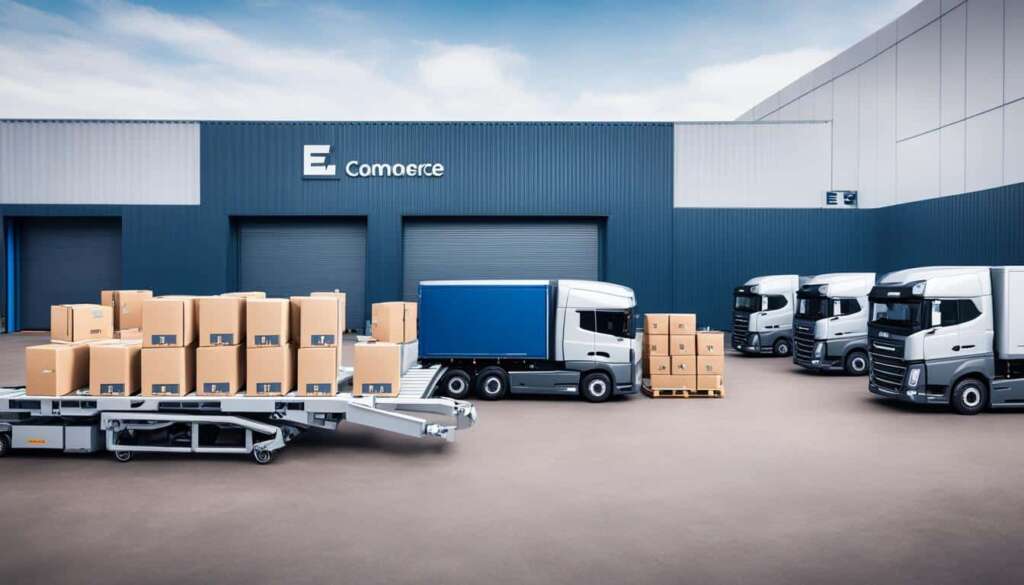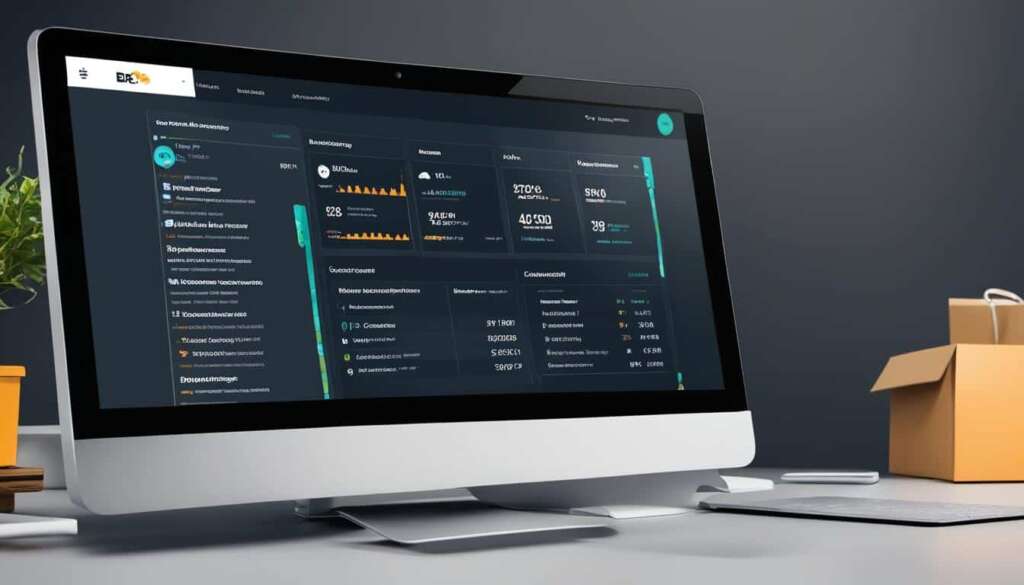Table of Contents
Welcome to our article on lean e-commerce, a business methodology that focuses on efficiency, minimal waste, and continuous improvement. In today’s rapidly evolving digital landscape, it’s crucial for e-commerce businesses to streamline their sales processes to stay competitive and meet customer expectations.
By adopting a lean e-commerce approach, businesses can optimize their operations to reduce costs, accelerate time to market, improve customer satisfaction, and align their processes with customer needs. This methodology emphasizes data-driven decision-making, experimentation, and a constant drive for improvement.
In this article, we will explore what lean e-commerce is, outline its benefits, compare it to traditional e-commerce, and discuss how it can be applied to both large and small businesses. We will also delve into the principles of lean e-commerce and provide insights on reducing costs and increasing profits in the e-commerce industry.
Whether you are a small start-up or a large enterprise, adopting a lean e-commerce approach can revolutionize your sales processes and pave the way for success in the digital marketplace. So, let’s dive in and explore the essential principles and strategies of lean e-commerce!
What is Lean Ecommerce?
Lean ecommerce is a business methodology that prioritizes efficiency, minimal waste, and continuous improvement. It draws inspiration from lean principles, including defining value, value stream mapping, creating flow, establishing pull, and continuous improvement. Unlike traditional planning and forecasting methods, lean ecommerce centers around continuous experimentation and iteration to find the most effective solutions. Its goal is to build a sustainable and profitable ecommerce business by constantly improving processes and making data-driven decisions.
Key Principles of Lean Ecommerce:
- Defining Value: Understanding what is valuable from the customer’s perspective and focusing on delivering that value.
- Value Stream Mapping: Analyzing the flow of activities and processes to identify waste and inefficiencies.
- Creating Flow: Streamlining processes and eliminating bottlenecks to achieve a continuous and smooth flow of work.
- Establishing Pull: Responding to customer demand by using a just-in-time approach to production and delivery.
- Continuous Improvement: Actively seeking opportunities for improvement, experimenting with new ideas, and making iterative changes.
“Lean ecommerce focuses on continuous experimentation and iteration to find the most effective solutions.”
This image represents the essence of lean ecommerce – a continuous improvement cycle that drives efficiency and minimizes waste.
| Benefits of Lean Ecommerce | Traditional Ecommerce Approaches |
|---|---|
| 1. Increased efficiency | 1. Emphasis on growth and scale |
| 2. Cost reduction | 2. Mass production and marketing strategies |
| 3. Improved customer satisfaction | 3. Reliance on established processes and procedures |
| 4. Accelerated time to market | 4. Intuition-based decision making |
| 5. Data-driven decision making | 5. Less emphasis on customer feedback and data |
By embracing the principles of lean ecommerce, businesses can reduce costs, increase efficiency, improve customer satisfaction, and stay ahead of the competition in the fast-paced ecommerce industry.
Benefits of Lean Ecommerce
Adopting a lean ecommerce approach offers numerous benefits for businesses. It improves profitability by reducing costs and utilizing resources efficiently. It also accelerates time to market for new products and features, reinforcing customer satisfaction and loyalty. Lean ecommerce enables businesses to quickly respond to market changes, drives an improved website user experience, aids in data-driven decision making, and aligns business processes more closely to customer needs.
When businesses embrace lean ecommerce principles, they are empowered to achieve greater profitability through cost reduction and resource optimization. By eliminating unnecessary expenses and streamlining operations, lean ecommerce enables businesses to operate more efficiently, leading to increased profitability.
- Reduced costs
- Utilization of resources
- Improved profitability
- Accelerated time to market
- Enhanced customer satisfaction and loyalty
- Quick response to market changes
- Improved website user experience
- Data-driven decision making
- Aligned business processes to customer needs
Lean ecommerce allows businesses to identify and eliminate waste, enabling them to allocate resources more effectively and efficiently. This not only reduces costs but also allows businesses to invest those savings into areas that drive growth and innovation.
With lean ecommerce, businesses can increase their profitability by reducing costs and utilizing resources more efficiently.
Furthermore, lean ecommerce facilitates faster time to market for new products and features. By eliminating unnecessary steps in the production and launch process, businesses can bring their offerings to market more quickly, gaining a competitive advantage and capturing customer attention.
Customer Satisfaction and Loyalty
Lean ecommerce places an emphasis on customer satisfaction and loyalty. By aligning business processes more closely to customer needs, businesses can deliver enhanced experiences that meet or exceed customer expectations. This leads to increased customer satisfaction, higher retention rates, and greater customer loyalty.

Furthermore, lean ecommerce enables businesses to quickly respond to market changes. By continuously monitoring market trends and customer feedback, businesses can adapt their strategies and offerings to stay ahead of competitors and meet evolving customer demands.
By embracing a data-driven approach, lean ecommerce enables businesses to make informed decisions based on real-time insights. Analyzing customer data and metrics allows businesses to identify opportunities for improvement, optimize performance, and prioritize resources where they can have the greatest impact.
Lean Ecommerce vs. Traditional Ecommerce
Lean ecommerce and traditional ecommerce are distinct approaches with key differences in focus and strategies. While traditional ecommerce prioritizes growth and scale, lean ecommerce places emphasis on efficiency and customer value. Let’s explore some of the ways in which these two models differ:
1. Growth Orientation
In traditional ecommerce, the primary goal is often to achieve rapid growth and expand market share. This may involve mass production, mass marketing, and aggressive promotional tactics. On the other hand, lean ecommerce adopts a more measured approach, focusing on optimizing processes and delivering value to customers.
2. Just-in-Time vs. Established Procedures
Traditional ecommerce often relies on established processes and procedures, following a predetermined plan of action. In contrast, lean ecommerce embraces a just-in-time approach, emphasizing continuous improvement and testing. By remaining flexible and adaptable, lean ecommerce businesses can quickly respond to changing customer needs and market dynamics.
3. Feedback-Driven Decision Making
Customer feedback and user data play a central role in decision-making processes within the lean ecommerce framework. Businesses gather insights from customers to drive product development, refine marketing strategies, and improve overall customer experience. In traditional ecommerce, decision making may be based more on intuition and assumptions.
4. Continuous Improvement
Continuous improvement is a core principle of lean ecommerce. With a relentless focus on efficiency and value, lean ecommerce businesses are always seeking ways to streamline processes and eliminate waste. This iterative approach allows for ongoing optimization and enhances the overall customer experience. In traditional ecommerce, improvement efforts may be less systematic or structured.
“The Lean Ecommerce model emphasizes efficient processes and customer value, enabling businesses to stay ahead of the competition.” – Name Surname, Ecommerce Expert
Ultimately, lean ecommerce offers a more customer-centric and efficient approach, while traditional ecommerce may prioritize growth and scale. By adopting lean principles and a continuous improvement mindset, businesses can deliver exceptional customer value and drive long-term success in the ever-evolving ecommerce landscape.
| Lean Ecommerce | Traditional Ecommerce | |
|---|---|---|
| Primary Focus | Efficiency and customer value | Growth and scale |
| Approach | Just-in-time, continuous improvement | Established processes, mass production |
| Decision Making | Data-driven, feedback-oriented | Intuition, assumptions |
| Continuous Improvement | Core principle | Less structured or systematic |
Applying Lean Ecommerce to Large Businesses
Lean ecommerce principles are not limited to small businesses; they can also be applied effectively to large businesses in the e-commerce industry. While the core focus on continuous improvement, waste reduction, and customer value remains the same, the implementation of lean principles may require some adaptations to suit the specific context and scale of large enterprises.
When applying lean ecommerce to large businesses, it is crucial to carefully assess and streamline existing processes to eliminate waste and optimize efficiency. Large businesses often have complex systems and hierarchies that can hinder agility and hinder the implementation of lean methodologies. However, by breaking down silos, fostering collaboration, and empowering cross-functional teams, large businesses can overcome these challenges and create a culture of continuous improvement.
One of the key benefits of lean ecommerce for large businesses is the potential for substantial cost reduction. By identifying and eliminating non-value-added activities, businesses can streamline their operations and allocate resources more efficiently. This not only leads to cost savings but also frees up valuable resources that can be redirected towards activities that create customer value and drive growth.
Another way in which large businesses can benefit from lean ecommerce is through improved customer satisfaction. By adopting lean principles, companies can better understand customer needs and preferences, leading to the development of products and services that align more closely with customer expectations. This, in turn, can result in higher customer satisfaction rates and increased customer loyalty.
Implementing Lean Ecommerce in Large Businesses: Challenges and Solutions
Large businesses face unique challenges when implementing lean ecommerce practices. Some of these challenges include:
- Resistance to change: Large organizations often have established processes and systems that can resist change. Overcoming this resistance requires effective change management strategies, including clear communication, employee engagement, and leadership buy-in.
- Scale: The scale of large businesses can make it more challenging to implement lean practices across all areas of the organization. To address this, businesses can start by focusing on specific departments or areas and gradually expand lean practices throughout the organization.
- Legacy systems: Large businesses may have legacy systems that are not optimized for lean practices. Upgrading or replacing these systems can be a significant undertaking, but it is necessary for long-term lean success.
To mitigate these challenges and maximize the benefits of lean ecommerce, large businesses can:
“Large businesses can successfully adopt lean ecommerce by breaking down silos, fostering collaboration, and empowering cross-functional teams. By aligning their efforts towards waste reduction, continuous improvement, and customer value, large enterprises can create a more sustainable and profitable e-commerce operation.”
By implementing lean ecommerce principles, large businesses can achieve the following:
| Benefits | Large Businesses |
|---|---|
| Increased efficiency | Optimized resource allocation and streamlined processes lead to improved efficiency and productivity. |
| Reduced costs | Identification and elimination of waste result in cost savings and better resource utilization. |
| Improved customer satisfaction | Deep understanding of customer needs and preferences enables the development of products and services that align closely with customer expectations. |
| Enhanced agility | Lean practices allow large businesses to respond quickly to market changes, adapt to customer demands, and stay ahead of the competition. |
Through the application of lean ecommerce principles, large businesses can transform their operations, increase efficiency, reduce costs, and ultimately create a more sustainable and profitable e-commerce operation.
Principles of Lean Ecommerce
In order to maximize efficiency and minimize waste in online businesses, the principles of lean ecommerce are derived from the Lean Startup methodology. Through the application of these principles, businesses can reduce costs, increase efficiency, and drive continuous improvement, enabling them to stay competitive in the dynamic e-commerce industry.
Here are the key principles of lean ecommerce:
- Validating the market: Prior to investing significant resources, it is crucial to validate the market and ensure there is demand for the product or service being offered. This involves conducting market research, gathering customer feedback, and analyzing market trends to make informed decisions.
- Building a minimum viable product (MVP): Instead of developing a fully-featured product from the start, lean ecommerce encourages the creation of a minimum viable product that focuses on delivering the core value proposition. This allows businesses to test their ideas quickly and gather feedback for continuous improvement.
- Focusing on the customer: Customer-centricity is at the heart of lean ecommerce. By closely understanding customer needs, preferences, and pain points, businesses can develop products and services that truly add value and meet customer expectations.
- Continuously measuring and improving: Lean ecommerce emphasizes the importance of data-driven decision making and continuous improvement. By setting measurable metrics and regularly analyzing key performance indicators (KPIs), businesses can identify areas for improvement and make data-backed decisions to enhance their operations.
- Embracing failure: Failure is viewed as an opportunity for learning and growth in lean ecommerce. By embracing failure and adopting a mindset of experimentation, businesses can quickly identify what works and what doesn’t, enabling them to iterate and improve their products and processes.
- Streamlining processes: Lean ecommerce focuses on eliminating waste and inefficiencies in processes. By mapping out value streams, identifying non-value added activities, and streamlining workflows, businesses can optimize their operations, reduce costs, and improve overall efficiency.
- Fostering collaboration and innovation: Collaboration and innovation are essential elements of lean ecommerce. By encouraging cross-functional collaboration, promoting a culture of innovation, and providing channels for employee ideas and feedback, businesses can drive creativity, problem-solving, and continuous innovation.
By embracing these principles, businesses can create a lean ecommerce operation that maximizes efficiency, eliminates waste, and fosters continuous improvement and innovation.

Reducing Costs and Increasing Profits with Lean Ecommerce
Lean ecommerce is a powerful approach that can help businesses reduce costs and increase profitability. By implementing strategies focused on cost reduction, waste elimination, efficiency, and data-driven decision making, businesses can optimize their operations and achieve significant financial gains.
One of the key principles of lean ecommerce is continuous improvement. By constantly evaluating processes and identifying areas of waste, businesses can streamline their operations and eliminate unnecessary expenses. This approach ensures that every activity adds value to the business and contributes to its overall success.
Just-in-time inventory management is another important aspect of lean ecommerce that can lead to cost reduction. By minimizing inventory levels and optimizing supply chains, businesses can lower inventory holding costs and reduce the risk of stock obsolescence. This not only increases efficiency but also improves cash flow and reduces financial risk.
Efficiency plays a crucial role in lean ecommerce. By streamlining processes, businesses can save time and resources, ultimately leading to cost savings. By analyzing workflow, identifying bottlenecks, and implementing improvements, businesses can optimize their operations and maximize productivity. This results in reduced costs and increased profitability.
Data-driven decision making is a fundamental component of lean ecommerce. By gathering and analyzing data, businesses can make informed decisions that are based on real-world insights. This enables them to allocate resources more effectively, tailor their products and services to customer needs, and drive long-term growth and profitability.
Through a focus on cost reduction, waste elimination, efficiency, and data-driven decision making, lean ecommerce offers businesses the opportunity to optimize their operations and achieve sustainable financial success.
Key Strategies for Reducing Costs and Increasing Profits in Lean Ecommerce
Implementing lean ecommerce strategies requires a comprehensive approach that encompasses various aspects of the business. The following key strategies can help businesses reduce costs and increase profits:
- Identify and eliminate non-value-added activities: By identifying activities that do not add value to the customer or the business, businesses can minimize waste and increase efficiency.
- Optimize supply chains: Streamlining supply chains can reduce costs associated with procurement, inventory management, and logistics.
- Improve inventory management: Adopting just-in-time inventory practices can help reduce holding costs and minimize the risk of stock obsolescence.
- Streamline processes: Analyze workflows, identify inefficiencies, and implement process improvements to maximize productivity and reduce costs.
- Employ automation and technology: Utilize automation and technology solutions to streamline operations, improve efficiency, and reduce labor costs.
- Make data-driven decisions: Leverage customer data, market insights, and analytics to drive informed decision making and optimize resource allocation.
- Continuously monitor and improve: Regularly assess performance, gather feedback, and make iterative improvements to achieve ongoing cost reduction and profitability gains.
By adopting these strategies and embracing the principles of lean ecommerce, businesses can effectively reduce costs, increase profits, and build a sustainable and successful ecommerce operation.
Case Study: Cost Reduction and Profit Increase in Ecommerce Business X
| Metrics | Before Lean Ecommerce | After Lean Ecommerce |
|---|---|---|
| Annual Operating Costs | £500,000 | £350,000 |
| Inventory Holding Costs | £100,000 | £60,000 |
| Profit Margin | 10% | 15% |
In the case of Ecommerce Business X, implementing lean ecommerce practices resulted in significant cost reduction and profit increase. By employing strategies such as process optimization, just-in-time inventory management, and data-driven decision making, the business was able to reduce their annual operating costs by £150,000. Additionally, inventory holding costs decreased by £40,000, contributing to improved cash flow and reduced financial risk. The combination of cost reduction and increased efficiency led to a higher profit margin of 15%, compared to the previous 10%.
Conclusion
Adopting a lean e-commerce approach can revolutionize sales processes by prioritising efficiency, minimal waste, and continuous improvement. By implementing lean principles and strategies, businesses can reduce costs, accelerate time to market, improve customer satisfaction, and increase profitability.
Lean e-commerce emphasises data-driven decision making, collaboration, and innovation, allowing businesses to stay ahead of the competition in the fast-paced e-commerce industry. By continuously improving processes and aligning them with customer needs, businesses can build sustainable and profitable e-commerce operations.
By embracing the tenets of lean e-commerce, businesses can streamline their operations, eliminate waste, and uncover opportunities for growth. The focus on continuous improvement enables businesses to make data-driven decisions and optimize their processes for maximum efficiency. With lean e-commerce, companies can drive profitability while delivering value to customers, strengthening their position in the competitive e-commerce landscape.
FAQ
What is lean e-commerce?
Lean e-commerce is a business methodology that focuses on minimizing waste and maximizing efficiency in order to provide a better user experience and increase profitability. It emphasizes continuous improvement, data-driven decision-making, and experimentation to find the most effective solutions.
What are the benefits of adopting a lean e-commerce approach?
Adopting a lean e-commerce approach offers numerous benefits for businesses. It improves profitability by reducing costs and utilizing resources efficiently. It also accelerates time to market for new products and features, reinforcing customer satisfaction and loyalty. Lean e-commerce enables businesses to quickly respond to market changes, drives an improved website user experience, aids in data-driven decision making, and aligns business processes more closely to customer needs.
How does lean e-commerce differ from traditional e-commerce?
Lean e-commerce differs from traditional e-commerce in several ways. While traditional e-commerce often focuses on growth and scale, lean e-commerce prioritizes efficiency and customer value. Traditional e-commerce may use mass production and mass marketing strategies, while lean e-commerce embraces a just-in-time approach. Lean e-commerce emphasizes continuous improvement and testing, while traditional e-commerce may rely on established processes and procedures. Lean e-commerce also prioritizes customer feedback and user data in decision-making, while traditional e-commerce may rely on intuition and assumptions.
Can lean principles be applied to large businesses in the e-commerce industry?
Yes, the principles of lean e-commerce can be applied to large businesses in the e-commerce industry. While the focus on continuous improvement, waste reduction, and customer value remains the same, the implementation may need to be adapted to the specific context and scale of the large business. By adopting lean principles, large businesses can benefit from increased efficiency, reduced costs, improved customer satisfaction, and a more sustainable and profitable e-commerce operation.
What are the guiding principles of lean e-commerce?
The principles of lean e-commerce are based on the Lean Startup methodology and aim to maximize efficiency and minimize waste in online businesses. These principles include validating the market, building a minimum viable product (MVP), focusing on the customer, continuously measuring and improving, embracing failure, streamlining processes, and fostering collaboration and innovation. By embracing these principles, businesses can reduce costs, increase efficiency, and drive continuous improvement to stay competitive in the e-commerce industry.
How does lean e-commerce help reduce costs and increase profits?
Lean e-commerce helps reduce costs and increase profits by promoting continuous improvement and waste elimination. By focusing on the most valuable activities and eliminating waste, businesses can reduce costs and increase efficiency. Lean e-commerce also emphasizes just-in-time inventory management, which reduces inventory costs and minimizes the risk of stock obsolescence. By streamlining processes and improving efficiency, businesses can save time and money. By focusing on customer needs, gathering feedback, and making data-driven decisions, businesses can improve their products and services, leading to increased customer loyalty and sales.
How can lean e-commerce revolutionize sales processes?
Adopting a lean e-commerce approach can revolutionize sales processes by prioritizing efficiency, minimal waste, and continuous improvement. By implementing lean principles and strategies, businesses can reduce costs, accelerate time to market, improve customer satisfaction, and increase profitability. Lean e-commerce emphasizes data-driven decision making, collaboration, and innovation, allowing businesses to stay ahead of the competition in the fast-paced e-commerce industry. By continuously improving processes and aligning them with customer needs, businesses can build sustainable and profitable e-commerce operations.













